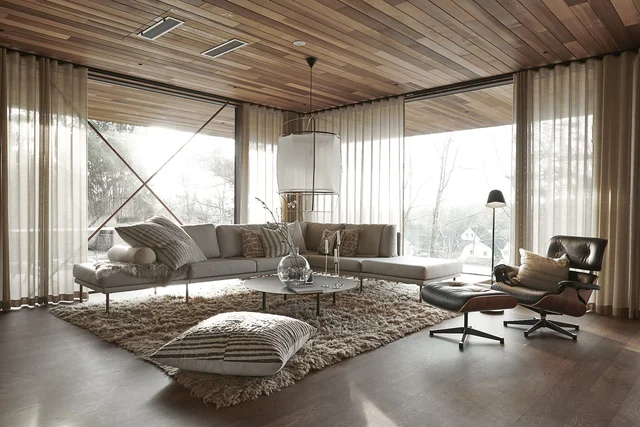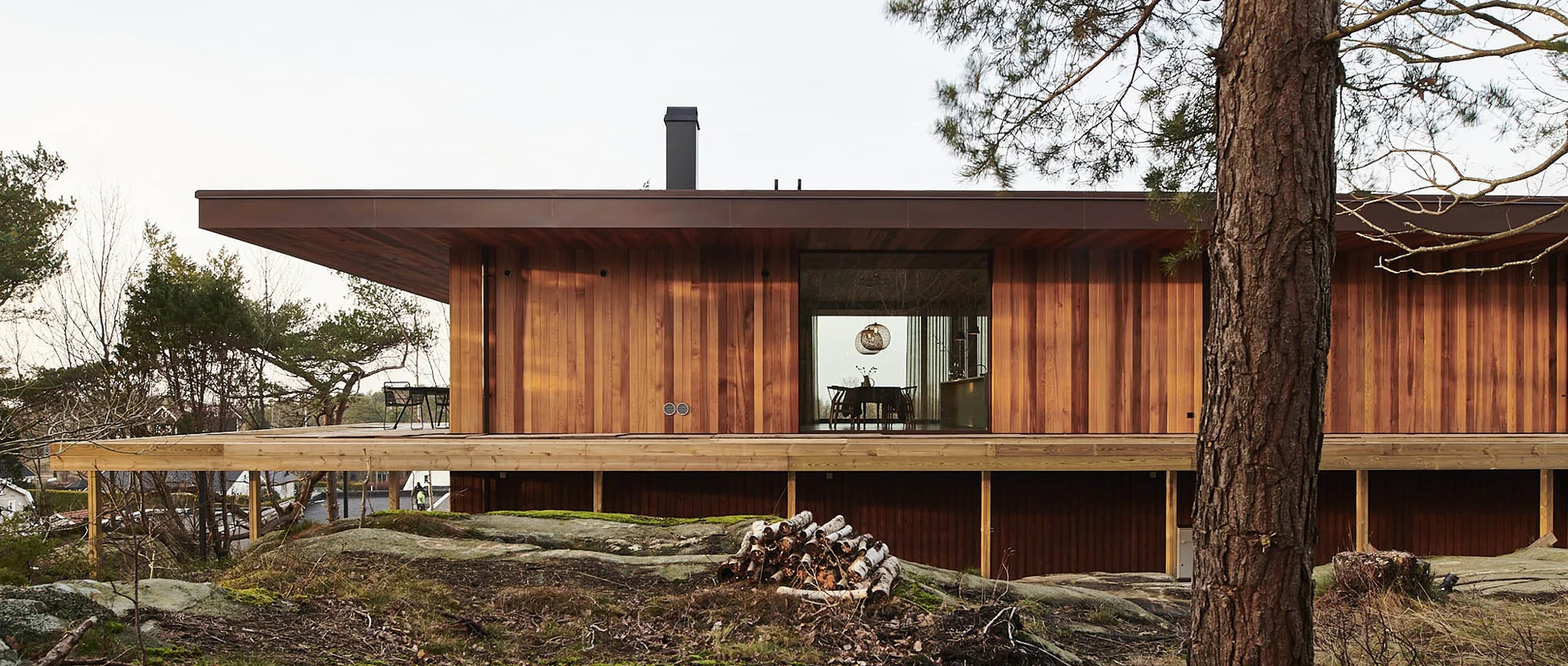
VILLA CLARA, a modern dream home on the Swedish west coast
The site was intended for a customer project, but instead Henrik Schulz decided to use it to build his own dream home. Now Villa Clara has finally been completed and the whole process was documented by Swedish national television. Fristads visited the construction site last autumn and met both the architect and the builders behind the project.
t is not difficult to find the Schulz family home among all the white-painted wooden houses and sand-lime brick residences – this is a building that is both easily visible and stands out in the otherwise fairly uniform surroundings. The site is located on a steep slope at the top of a hill in Hovås municipality just south of Gothenburg. However, where others simply saw hilly terrain and inaccessible nature, Henrik saw opportunities. It was here, with the forest as the backdrop and the Kattegat Sea around the corner, that he decided to carry out his own dream project. He would build a house for himself and his family that would be quite unlike anything else in Sweden or elsewhere in Europe.
“When we first came here the site was just a hill. People had a hard time visualising what could become of it. But I guess that is where my profession as an architect helps me,” says Henrik.
He describes the architecture as a fusion of 1950s and ’60s Los Angeles and South America, combined with modern international Scandinavian design. The finished house will become an oasis, a place for recovery and tranquillity where one can meditatively enjoy nature among the trees. Influenced by architects like Mies van der Rohe and Marcio Kogan, Henrik Schulz wants to go back to the roots of modernism and put the finishing touches to their contemporary ideas that a house, like a well-functioning machine, should facilitate the lives of its users.

The site was intended for a customer project, but instead Henrik Schulz decided to use it to build his own dream home. Now Villa Clara has finally been completed and the whole process was documented by Swedish national television. Fristads visited the construction site last autumn and met both the architect and the builders behind the project.
It is not difficult to find the Schulz family home among all the white-painted wooden houses and sand-lime brick residences – this is a building that is both easily visible and stands out in the otherwise fairly uniform surroundings. The site is located on a steep slope at the top of a hill in Hovås municipality just south of Gothenburg. However, where others simply saw hilly terrain and inaccessible nature, Henrik saw opportunities. It was here, with the forest as the backdrop and the Kattegat Sea around the corner, that he decided to carry out his own dream project. He would build a house for himself and his family that would be quite unlike anything else in Sweden or elsewhere in Europe.

“When we first came here the site was just a hill. People had a hard time visualising what could become of it. But I guess that is where my profession as an architect helps me,” says Henrik.
He describes the architecture as a fusion of 1950s and ’60s Los Angeles and South America, combined with modern international Scandinavian design. The finished house will become an oasis, a place for recovery and tranquillity where one can meditatively enjoy nature among the trees. Influenced by architects like Mies van der Rohe and Marcio Kogan, Henrik Schulz wants to go back to the roots of modernism and put the finishing touches to their contemporary ideas that a house, like a well-functioning machine, should facilitate the lives of its users.
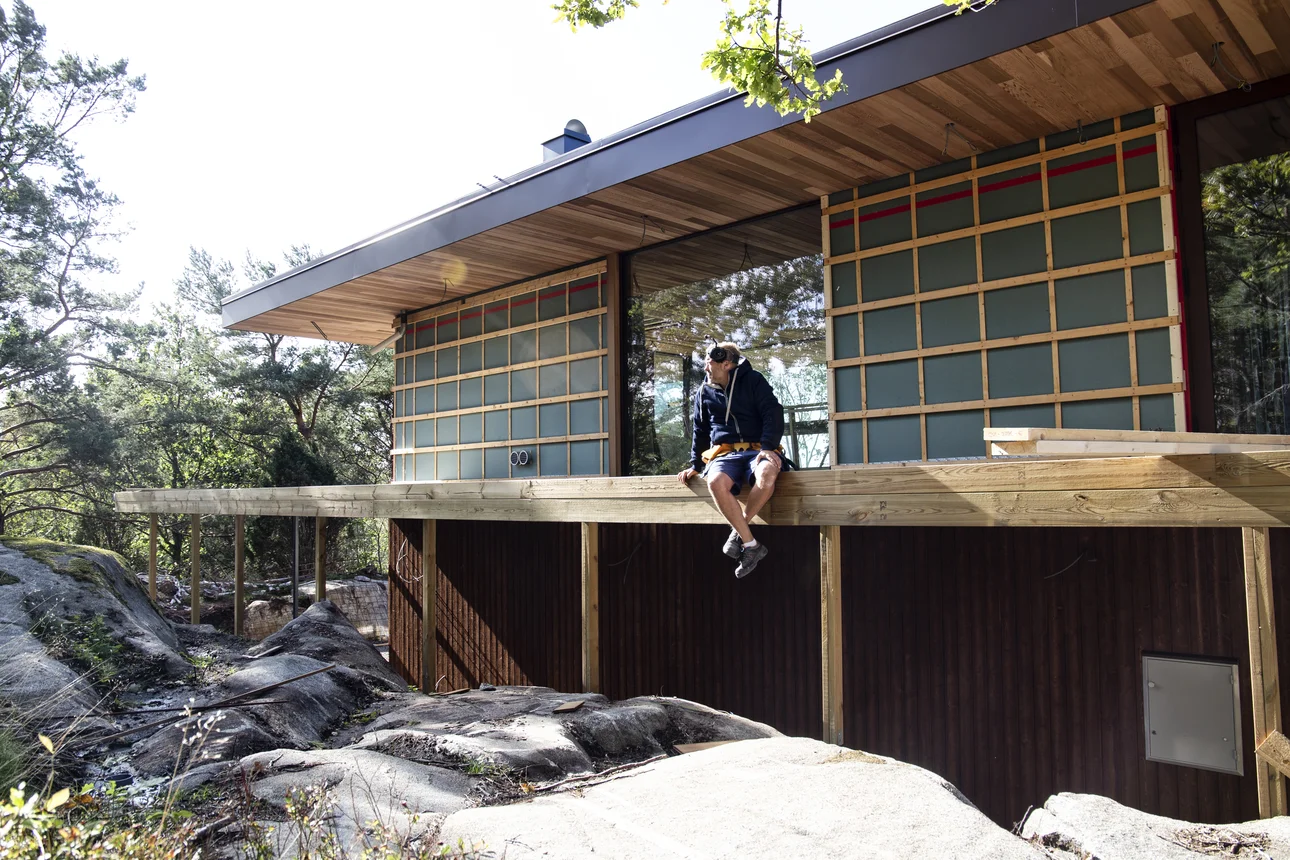
The groundwork began in November 2018 and four months later two builders, Håkan Molldén and Erik Jacobsson, were hired full-time to take charge of the construction. Both saw the architecture as an exciting challenge.
“The best part of an assignment like this is that for once, you can allow yourself to be a real geek when it comes to the materials and details,” Erik says.
“I agree”, says Håkan. “It's really cool to be able to do something so different,” he continues.
And different is just what it is. The oiled cedar panel in a warm shade contrasts with huge glass panels and powder-coated frames that invisibly blend into the structure. The roof overhang in cedar wood conceals a steel structure, allowing the panelled ceiling to extend throughout the building and blur the line between outside and inside. The thick triple-glazed windows are laminated on the inside and hardened on the outside, and each weighs between 400 kg and a tonne. Outside on the terrace the deck is framed by a 16 mm thick glass panel without an overlay, mounted in a rail to let the light shine in and at the same time offer invisible protection.
“I hope this house will pave the way for a new trend, both in Sweden and Europe,” says Henrik. “Making people a bit bolder, stretching the limits and prompting them to think a little more outside the box.”
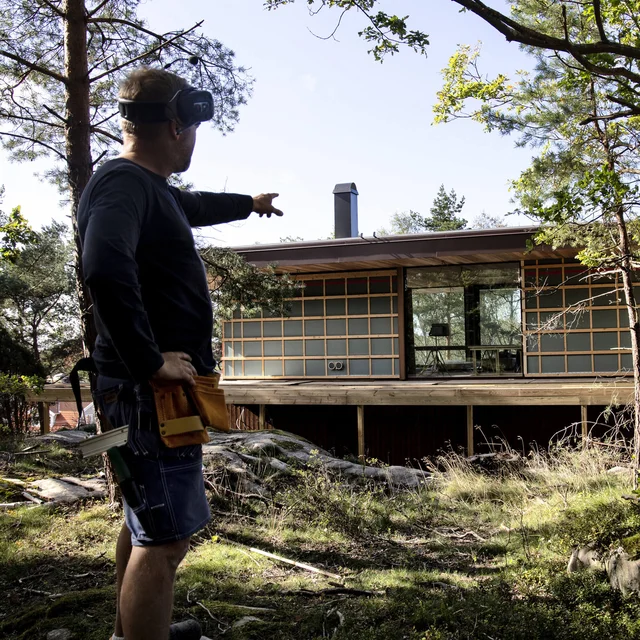
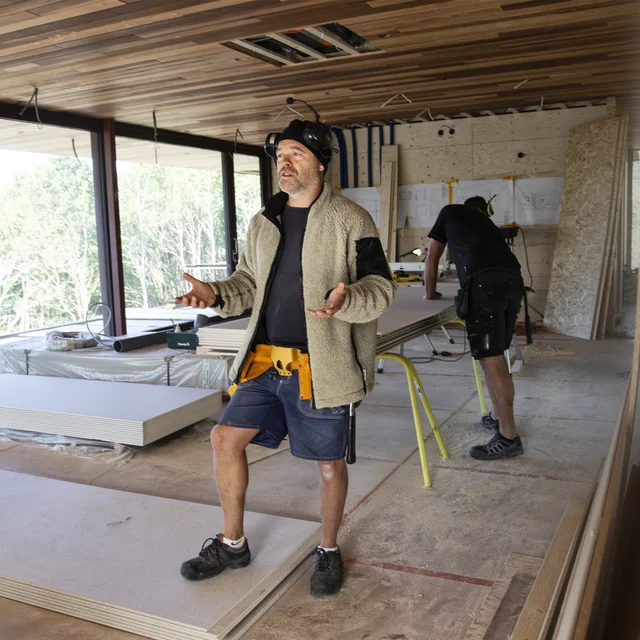

The groundwork began in November 2018 and four months later two builders, Håkan Molldén and Erik Jacobsson, were hired full-time to take charge of the construction. Both saw the architecture as an exciting challenge.
“The best part of an assignment like this is that for once, you can allow yourself to be a real geek when it comes to the materials and details,” Erik says.
“I agree”, says Håkan. “It's really cool to be able to do something so different,” he continues.
And different is just what it is. The oiled cedar panel in a warm shade contrasts with huge glass panels and powder-coated frames that invisibly blend into the structure. The roof overhang in cedar wood conceals a steel structure, allowing the panelled ceiling to extend throughout the building and blur the line between outside and inside. The thick triple-glazed windows are laminated on the inside and hardened on the outside, and each weighs between 400 kg and a tonne. Outside on the terrace the deck is framed by a 16 mm thick glass panel without an overlay, mounted in a rail to let the light shine in and at the same time offer invisible protection.
“I hope this house will pave the way for a new trend, both in Sweden and Europe,” says Henrik. “Making people a bit bolder, stretching the limits and prompting them to think a little more outside the box.”

In addition to Henrik and his partner Lina, the family also includes their daughter Clara, 2 years old. Clara, for whom the house is named, has been taken into consideration in every detail of the floor plan. This becomes clear when Henrik talks about his vision. Clara's childhood experience in the house is central, this is a flexible home that could easily be adapted to the changing needs of the family. Therefore, the house is built on a sloping hillside.
On each floor there are bathrooms, bedrooms and living areas located vertically above each other. The entrance will be on the upper floor when the detailed plan for the residential area is completed, but until then it is the front door on the ground floor that is mainly used. As long as Clara is a child, the family will sleep on the ground floor, but as a teenager she will be allowed to live there by herself while her parents move upstairs.
Despite its design, the house is very energy-efficient and sustainability permeates the entire building. The large windows were carefully selected for their energy-efficiency, and geothermal heating warms up the white pigmented cement floors. The roof-mounted cooling system only consumes ten percent of the energy that an air conditioner would use, and in the middle of the ground floor the house's technical brain has been placed. Henrik shows the solid pillar that holds all the technology and connects all the cables and wires that run throughout the house, well hidden behind the walls and under the floors. It is from here that the alarm system, electricity supply, heating and cooling are controlled.
Just like the rest of the house, the technology plan breathes perfection, everything is carefully selected, nothing has been left to chance. We ask Henrik how, as head of the construction project, he reasoned about his choice of work wear while working on the project.
I love workwear and I've worn Fristads garments ever since I served my apprenticeship as a joiner in my youth. I love the cut, the features and the fact that the garments last. I never compromise on quality!”
In addition to Henrik and his partner Lina, the family also includes their daughter Clara, 2 years old. Clara, for whom the house is named, has been taken into consideration in every detail of the floor plan. This becomes clear when Henrik talks about his vision. Clara's childhood experience in the house is central, this is a flexible home that could easily be adapted to the changing needs of the family. Therefore, the house is built on a sloping hillside.
On each floor there are bathrooms, bedrooms and living areas located vertically above each other. The entrance will be on the upper floor when the detailed plan for the residential area is completed, but until then it is the front door on the ground floor that is mainly used. As long as Clara is a child, the family will sleep on the ground floor, but as a teenager she will be allowed to live there by herself while her parents move upstairs.
Despite its design, the house is very energy-efficient and sustainability permeates the entire building. The large windows were carefully selected for their energy-efficiency, and geothermal heating warms up the white pigmented cement floors. The roof-mounted cooling system only consumes ten percent of the energy that an air conditioner would use, and in the middle of the ground floor the house's technical brain has been placed. Henrik shows the solid pillar that holds all the technology and connects all the cables and wires that run throughout the house, well hidden behind the walls and under the floors. It is from here that the alarm system, electricity supply, heating and cooling are controlled.
Just like the rest of the house, the technology plan breathes perfection, everything is carefully selected, nothing has been left to chance. We ask Henrik how, as head of the construction project, he reasoned about his choice of work wear while working on the project.
“I love workwear and I've worn Fristads garments ever since I served my apprenticeship as a joiner in my youth. I love the cut, the features and the fact that the garments last. I never compromise on quality!”


In November 2019, one year after the groundwork began, Villa Clara was ready to welcome its residents. An intensive period of many construction hours and hard work was over. Henrik Schulz looks back on the past year and finds that almost everything worked according to plan. The human factor is something that always has to be taken into account in a large project, but with good preparation, thoughtful planning and some extra time, Henrik's dream home was built just as planned. Now the family has started to settle down and all three are enjoying themselves in their new home.
“I hope we can settle down a little now as a family and enjoy the house, instead of rushing into new projects and things to do. It is fantastic fun to build houses, but it is also incredibly exhausting. Especially if you are a bit of a perfectionist like I am,” concludes Henrik.
This spring there will still be some groundwork to do around the house, but Henrik and Lina have already created their quiet oasis within the wood-clad exterior walls. The rooms are furnished in a modern style and the open floorplan gives Clara plenty of space to play in. Their dream house has become a home.
In November 2019, one year after the groundwork began, Villa Clara was ready to welcome its residents. An intensive period of many construction hours and hard work was over. Henrik Schulz looks back on the past year and finds that almost everything worked according to plan. The human factor is something that always has to be taken into account in a large project, but with good preparation, thoughtful planning and some extra time, Henrik's dream home was built just as planned. Now the family has started to settle down and all three are enjoying themselves in their new home.
“I hope we can settle down a little now as a family and enjoy the house, instead of rushing into new projects and things to do. It is fantastic fun to build houses, but it is also incredibly exhausting. Especially if you are a bit of a perfectionist like I am,” concludes Henrik.
This spring there will still be some groundwork to do around the house, but Henrik and Lina have already created their quiet oasis within the wood-clad exterior walls. The rooms are furnished in a modern style and the open floorplan gives Clara plenty of space to play in. Their dream house has become a home.
